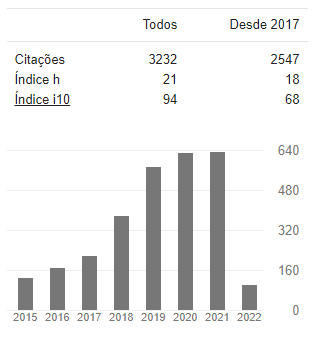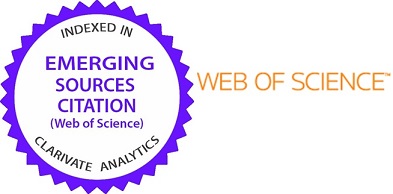Actions and changes in the logistics policy in pandemic times: a case study of a funeral home
DOI:
https://doi.org/10.15628/holos.2020.11291Palavras-chave:
Logistics, Funeral Industry, Pandemic, COVID-19.Resumo
The purpose of this article is to understand the actions and processes of change made in the logistics policy of a funeral home operating in Northeast Brazil to cope with the period of the COVID-19 pandemic. The paper addresses an exploratory case study with a qualitative analytical approach, which used a semi-structured interview script to collect data from the operations manager of the company in question, videoconferenced in July 2020. The survey was designed in four stages: (1) construction of theoretical subsidies; (2) interview with the operations manager; (3) return to the interviewee to consolidate the collected data; (4) analysis of the main changes occurring in the organisation’s logistics process during the pandemic. The results of the analysis helped conclude that the context of the public health crisis generated actions in and a need to re-adapt the firm’s logistics policy for transport, procurement and inventory, in order to ensure continuity of the funeral services rendered, without detriment to the consumers of the funeral plans and new clients.
Downloads
Referências
Akyel, D. (2011, June 23). The economization of the sacred: The transformation of the death care industry in Germany. Paper presented at the Annual Meeting of the SASE Annual Conference, Spain: Autonomous University of Madrid. Retrieved from http://citation.allacademic.com/meta/p498209_index.html
Alves-Mazzoti, A.J. (2004). As ciências sociais são ciências. [Social sciences are sciences] Alves-Mazzoti, A.J; Gewandsznajder, F. The method in natural and social sciences – a qualitative and quantitative study, 2, 112-128.
Assunção, M.V.D.; Medeiros, M.; Moreira, L.N.R.; Paiva, I.V.L., & de Souza Paes, D.C.A. (2020). Resilience of the Brazilian supply chains due to the impacts of COVID-19. HOLOS, 5, 1-20.
Bajardi, P.; Poletto, C.; Ramasco, J.J.; Tizzoni, M.; Colizza, V., & Vespignani, A. (2011). Human mobility networks, travel restrictions, and the global spread of 2009 H1N1 Pandemic. PLoS One, 6(1), e16591.http://doi.org/10.1371/journal.pone.0016591
Ballou, R.H. (2007). The evolution and future of logistics and supply chain management. European Business Review, 19(4), 332 - 348.
Bowersox, D.J.; Closs, D.J.; Cooper, M.B., & Bowersox, J. (2013). Supply Chain Logistics Management. McGraw Bill International Edition. New York, NY, USA.
Brooks, S.K.; Webster, R.K.; Smith, L.E.; Woodland, L.; Wessely, S.; Greenberg, N., & Rubin, G.J. (2020). The psychological impact of quarantine and how to reduce it: Rapid review of the evidence. The Lancet, 395(102227), 912-20. http://doi.org/10.1016/S0140-6736(20)30460-8
Eisenhardt, K. M. (1989). Building theories from case study research. Academy of Management Review, 14(4), 532-550.
Fan, Y.; Zhao, K.; Shi, Z.-L., & Zhou, P. Bat Coronaviruses in China. Viruses 2019, 11, 210.
Goody, J. & Poppi, C. (1994). Flowers and bones: Approaches to the dead in Anglo and Italian cemeteries. Comparative Studies in Society and History, 36, 146–175.
Hadders, H. (2013). Cremation in Norway: Regulation, changes and challenges. Mortality (Abingdon, England), 18(2), 195–213.
Hartley D. & Perencevich E. Public health interventions for COVID-19: Emerging evidence and implications for an evolving public health crisis. JAMA. 2020; (Published online April 10, 2020) https://doi.org/10.1001/jama.2020.5910
Hui & Guan, Y. (2006). Prevalence and Genetic Diversity of Coronaviruses in Bats from China. Journal of Virology. 80. 7481-90. 10.1128/JVI.00697-06.
Jacobs, J. (2008). Houses of life: Jewish cemeteries of Europe. Frances Lincoln.
Julianelli, L. Impacto da crise econômica na demanda: como melhorar a previsão de vendas? [Impact of the economic crisis on demand: How are sales forecasts improved?] Logistics and Supply Chain Specialists, 2015. Available at: https://www.ilos.com.br/web/impacto-da-crise-economica-na-demanda-como-melhorar-a-previsao-de-vendas/. Accessed: 4/8/2020.
Klaufus, C. (2016). “The dead are killing the living”: Spatial justice, funerary services and cemetery land use in urban Colombia. Habitat International, 54, 74–76.
Kopp, S. & Kemp, E. (2007). The death care industry: A review of regulatory and consumer issues. Journal of Consumer Affairs, 41(1), 150–173.
Liu Y.; Gayle A.A.; Wilder-Smith A., & Rocklöv J. The reproductive number of COVID-19 is higher compared to SARS coronavirus. J Travel Med. 2020 Mar;27(2):taaa021.
Mathijssen, B. & Venhorst, C. (2019). Funerary practices in the Netherlands. Emerald Publishing.
Mentzer, J.T.; DeWitt, W.; Keebler, J.S.; Min, S.; Nix, N.W.; Smith, C.D. & Zacharia, Z.G. (2001). Defining Supply Chain Management. Journal of Business Logistics, 22(2), 1–25.
Peiris J.S.M.; Lai S.T; Poon L.L.M. et al. Coronavirus as a possible cause of severe acute respiratory syndrome. Lancet 2003;361:1319-1325
Pellegrini, F.R., & Fogliatto, Flávio S. (2001). Passos para Implantação de Sistemas de Previsão de Demanda-Técnicas e Estudo de Caso. [Steps to implement demand forecast systems – Techniques and Case Study] In: Revista PRODUÇÃO, v. 11 n. 1, November 2001.
Rugg, J. (2015). Churchyard and cemetery (pp. 444). Manchester: Manchester University Press.
Rugg, J. (2020). Social justice and cemetery systems. Death Studies, 1-14.
Rugg, J., & Parsons, B. (2018). Funerary practices in England and Wales. Emerald Publishing.
Shi, Z., & Hu, Z. (2008). A review of studies on animal reservoirs of the SARS coronavirus. Virus research, 133(1), 74–87. https://doi.org/10.1016/j.virusres.2007.03.012
Silva, J.N.F.; Queiróz, C.S.R., & Soares, A.P. (2018). GESTÃO DE MATERIAIS NO SERVIÇO PÚBLICO: proposição de um modelo para os cemitérios de Rondonópolis–MT. [Materials Management in Public Service: Proposed model for cemeteries in Rondonópolis, Mato Grosso state] Revista Estudos e Pesquisas em Administração, 2(1), 118-133.
Sloane, D. (1991). The last great necessity: Cemeteries in American history (pp. 320). Baltimore: Johns Hopkins University Press.
Suzuki, H. (2000). The price of death, the funeral industry in contemporary Japan. Stanford: Stanford University Press.
Swafford, P.M.; Ghosh, S., & Murthy, N. (2006). The antecedents of supply chain agility of a firm: scale development and model testing. Journal of Operations Management, 24(2), 170-188.
Tang, X.C.; Zhang, J.X., & Zhang, S.Y. et al. Prevalence and genetic diversity of coronaviruses in bats from China. J Virol. 2006;80(15):7481-7490. doi:10.1128/JVI.00697-06
Virgulino, D.C.B., & de Souza Figueiredo, G.L.A. (2018). Gestão de estoque no ramo de serviços funerários: Estudo de caso entre duas empresas no município de Araguaína-TO. [Inventory management in the funerary service industry: Case study between two companies in the municipality of Araguaina, Tocantins State] Facit Business and Technology Journal, 1(6).
Walter, T. (2005). Three ways to arrange a funeral: Mortuary variation in the modern West. Mortality, 10(3), 173–192.
Walter, T. (2012). Why different countries manage death differently: A comparative analysis of modern urban societies. The British Journal of Sociology, 63(1), 123–145.
Webster, R.G. Wet markets--a continuing source of severe acute respiratory syndrome and influenza? Lancet. 2004;363(9404):234-236. doi:10.1016/S0140-6736(03)15329-9
White, D.B., & Lo, B. A Framework for Rationing Ventilators and Critical Care Beds during the COVID-19 Pandemic. JAMA. 2020;323(18):1773–1774. doi:10.1001/jama.2020.5046
Wood, Cate. (2020). Infections without borders: A new coronavirus in Wuhan, China. British Journal of Nursing. 29. 166-167. 10.12968/bjon.2020.29.3.166.
World Health Organization (2007). Risk reduction and emergency preparedness: World Health Organization six-year strategy for the health sector and community capacity development. Retrieved 10 April 2020, from http://apps.who.int/iris/bitstream/handle/10665/ 43736/9789241595896_eng.pdf?sequence=1&isAllowed=y
World Health Organization 2020. Coronavirus disease 2019 (COVID-19) situation report – 51 [Online]. Available at: https://www.who.int/docs/default-source/coronaviruse/situation-reports/20200311-sitrep-51-covid-19.pdf?sfvrsn=1ba62e57_10 (Accessed: 1 April 2020).
World Health Organization. Weekly Epidemiological Record, 2013, vol. 88, 35 [full issue]. Weekly Epidemiological Record. 2013, 88, 3.
World Health Organization. WHO Director-General‘s opening remarks at the media briefing on COVID-19 - 11 March 2020. World Health Organization, [S. l.], p. 1, 11 March 2020. Available at: https://www.who.int/dg/speeches/detail/who-director-general-s-opening-remarks-at-the-media-briefing-on-covid-19---11-Mar-2020. Accessed: 11 Aug 2020.65–380.
Yin, R.K. (2018). Pesquisa qualitativa do início ao fim. [Qualitative study from start to finish] Penso Editora.
Zanelli, J.C. (2002). Pesquisa qualitativa em estudos da gestão de pessoas. [Qualitative survey in people management studies] Estudos de Psicologia (Natal), 7(SPE), 79-88."









































